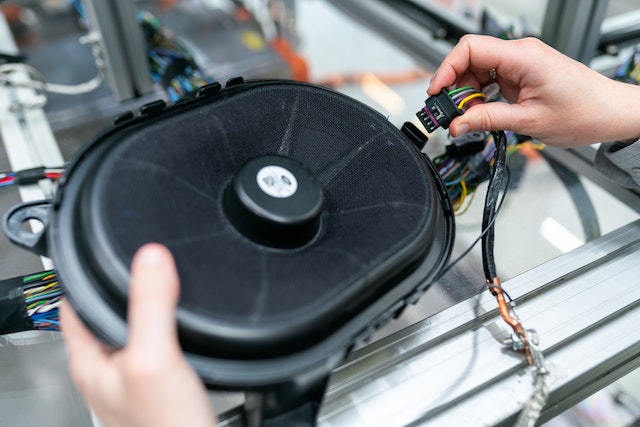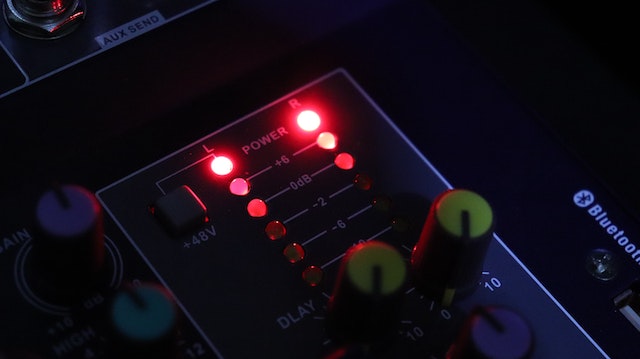AudioReputation is reader-supported. When you buy through links on our site, we may earn an affiliate commission Learn More
Many factors, including the type of wire insulation, wire length, temperature, and the ohms rating of your speaker load, determine the number of watts that a gauge speaker wire can handle.
However, in general, a 16-gauge speaker wire can hold between 50 and 100 watts of power, with shorter wires and better quality insulation being able to handle higher wattages.
Now, we understand that wiring can be tiring.
You are probably searching the internet to find if your 16 gauge wire is good for your speakers and subs and just exactly how many watts a 16 gauge speaker wire can handle.
Well, don’t worry. Having spent a large part of my summers setting up home theaters as a side gig, I know a lot about speaker wires, and I would love to help you with yours.
So, let’s dive in and understand the 16 Gauge speaker wire, its uses, max load, length, and every other question you have to get a rich and crisp audio quality from your speakers.
Table of Contents
How Many Watts Can A 16 Gauge Speaker Wire Handle?
Perfect for moderate uses in the car and home stereo speakers, 16 gauge speaker wires are designed to handle up to 100 watts for short runs.
However, the max load can increase to 225 watts when used in shorter lengths with low-power subwoofers.

A significant jump from the 18 gauge, the 16 gauge is 0.0105 thicker.
It can be useful in slightly bigger use cases such as a home theater or large automobiles since it is perfect for shorter runs and can handle moderately powerful speaker systems.
As both wire lengths and wattage can play a crucial role in defining the sound quality of your stereo system, it is very critical to not only select a wire gauge that can handle the wattage output of your speakers but also to keep in mind the exact length between your sound source and speaker.
Diving into the length of your 16 gauge speaker wire, it can largely differ depending upon the impedance of your speakers.
This is because most home stereos and car speakers that are expected to work with a 16 gauge wire have an impedance of 4, 6, or 8 ohms.
Coming to our speaker, a 16 gauge wire can run up to 24 feet when used with a 4-ohm speaker, 36 feet when used with a 6-ohm speaker, and up to 48 feet when used with an 8-ohm speaker.
That’s why these essential metrics, such as the speaker wattage output and impedance, are always mentioned on the speaker packaging, its user manual, and sometimes, it’s even written on the speaker itself.
Reading this information will help you determine the wire gauge and length that will work well with your speakers or home stereo and eventually give you premium audio quality and a good listening experience.
How To Choose The Right Wire Gauge For Your Speakers?
There are several things to consider before choosing a wire gauge for your new speakers.
Frustratingly while surfing the internet, you will find a lot of unrelated information, leaving you confused and needing clarification about the right wire gauge for your speakers.
Well, guess what? I have done the hard work for you. Based on my research, I’ve compiled and listed all the steps you need to follow to identify and select the wire gauge that will fit perfectly with your speakers and provide you with the best possible sound output and quality. So, let’s get started.
1. Diameter and Thickness

Before selecting a wire gauge for your speaker, the first thing to understand is the diameter and its importance in speaker wires.
Most commercially available speakers use wires of four different diameters, which include the 12 Gauge, 14 Gauge, 16 Gauge, and 18 Gauge.
Generally, a higher gauge number, in this case, means a wire with a smaller diameter or thickness.
In contrast, a lower gauge number means a wire with a bigger diameter.
This means that a 12 gauge speaker wire will always be thicker than a 14 gauge or a 16 gauge.
While it may not sound like much, wire thickness and diameter can largely affect the audio output for your speaker because it defines the overall resistance of your speaker circuit.
That said, a speaker wire with a larger diameter and thickness can handle more current than a speaker wire with a smaller diameter and relatively thinner.
Now, this doesn’t necessarily mean that a thicker wire is better than a thinner one since the diameter of your speaker wire depends largely upon the power output of your speakers.
2. Power Output
As discussed in the previous paragraph, power output is one of the most important things to consider before buying a speaker wire.
Now, to put it simply, power output is the amount of power given out by your stereo or amplifier and is measured in ‘watts’.
This is generally mentioned on your speaker packaging, its owner manual, and sometimes the speaker itself.
Once you have found the power output for your speaker, go ahead and search for a wire gauge that works perfectly with the mentioned power output.
Once you get a hold of it, power outputs can become easy to guess since they can be categorized depending on their usage.
You will soon find yourself guessing the correct wire gauges for different speakers without going through user manuals and information.
For example, when talking about car stereo systems, you would find that almost all of them have a power output of around 100 watts or so.
Therefore, they can work perfectly with a 16-gauge wire. However, larger speakers used in public places will use a 12 gauge instead.

3. Restriction of Power or Impedance
After you have checked your speaker’s power output, it is also essential to check out its restriction of power or impedance rating.
Generally measured in ohms, impedance refers to the restriction of power and its flow.
Speakers are widely available in both high and low impedances, both of which are used for different purposes.
Low-impedance speakers are generally used in small places such as homes and cars. In contrast, high-impedance speakers are used commercially in public places or gatherings with many people.
Speakers having a higher impedance are said to have better coil winding and the ability to punch through heavier air creating larger distortions and a far-traveling sound.
The impedance rating of your speaker will define the length of your speaker wire. Like power output, impedance rating can also be found in the speaker manual.
The impedance rating for most speakers is about 4, 6, or 8 ohms.
4. Length
The length of your speaker wire is probably one of the most difficult parts of setting up your speaker wire.
Before heading out to buy a speaker wire, it’s always a good idea to measure the distance between your audio source and speaker by using a string, just so that you don’t end up having a wire shortage.
I say this because speaker wire length depends upon both your speaker’s distance and impedance rating.
On top of it, the wattage rating can also be affected as length increases or decreases.
This is because a longer length creates a higher amount of resistance, thus limiting the power flow.
Similarly, maximum length can increase with an increasing impedance rating.
For example, a 16 AWG speaker wire can run up to 24, 36, and 48 feet, with speakers having an impedance of 4, 6 or 8 ohms.
To get a better idea of wire lengths, you can simply search for a speaker wire gauge chart and identify the perfect wire length depending on your wire gauge and impedance.
5. Material
The material of your speaker wire should always be considered since it plays an important role in the audio output quality.
Copper, one of the best conductors, is widely used for speaker wires and is the material you should aim for.
However, over the years, the manufacturers have started making speaker wires with a number of different materials, like aluminum and Copper Clad Aluminum.
However, I’ll still suggest using copper wire since it can give you optimal sound quality and is an industry standard for most speakers.
However, suppose you own a Copper Clad Aluminum (CCA) and don’t really want to change. In that case, you can still go for it, but you should keep in mind the load-bearing capacity of Copper Clad Aluminum wires.
In fact, copper-clad aluminum wires generally have a lower load-bearing capacity than copper wires since they are made by using conductor-grade aluminum as a core and copper only as its outermost layer.
On the other hand, speaker wires made with Oxygen Free Copper are purely made using copper. They can transfer sound in a much smoother way while also limiting energy losses in heat.
What Are The Two Different Types Of 16 Gauge Speaker Wire?
A 16 Gauge speaker wire is generally available in two different types, which include stranded and solid-core 16-gauge speaker wires.
Among these two, the stranded speaker wire is made using small and thin pieces of wire that are twisted together, whereas the solid core speaker wire, as the name suggests, has a heavy metal core.
Both of these wires have their own sets of advantages and disadvantages.

Like, a 16 gauge stranded wire has a higher flexibility since it is made from smaller, twisted pieces, and is mostly used in car and home-based applications.
On the other hand, a 16 gauge solid core speaker wire, due to its heavy core, has much higher durability and can perform in rugged conditions since it is resistant to extreme weather conditions and frequent movement.
FAQs
Yes. 16 gauge wires are one of the most common household speaker wires and can comfortably be used with mid-sized speakers for both automobiles and homes.
It is an industry-standard for most regular speakers since it provides the user with both a comfortable thickness and length.
The 16 gauge, however, should not be used for lengths longer than 24 feet, 36 feet, or 48 feet with speakers having an impedance rating of 4, 6, or 8 ohms since it affects quality and deprives you of getting the maximum audio output from your speakers.
The National Electric Code states that the most suitable load for a 16 gauge wire is 10 amps.
However, many appliances, such as speakers, extensions, and power cables, using 16 AWG, state 13 amps to be a suitable load.
Most electricians believe that both the ten amps and 13 amps rating is suitable for the 16 gauge wire since it performs optimally between those loads.
The max load for a 16 gauge wire can go up to 18 amps, provided that the wire insulation and temperature are at an optimal rate.
However, keeping a 16 gauge wire under an 18 amps load for longer time periods can possibly cause problems.
While they are not generally built for this purpose, 16 gauge or any other gauge speaker wires can carry some amount of electric current.
But speaker wires aren’t really plugged into electrical outlets, right? Well, yes, but this current-carrying characteristic helps it run speakers and woofers since their output is believed to have a small amount of electric current.
This is mostly true for audio amplifiers, which can give out around 14 to 28 or even higher voltages of electric currents.
The electric current output is mostly dependent upon the impedance of the audio amplifier being used.
That said, the premium quality 16 gauge speaker wires can even carry up to 90 volts of electricity, thus making them perfectly fine to make a connection between a speaker and an amplifier.
Relatively thinner than the 14 gauge wire used in most home circuits and lamps, the 16 gauge is used in light-duty extension cords and low-power appliances such as speakers since it has a median load capacity of 13 amps.
Also, extension cords built with a 16 gauge wire are not as reliable as ones made with a 14 gauge wire and will only be able to run low-power appliances, thus limiting your use-case.
No. The 16 gauge speaker wires are generally safe to touch and will not shock you even if you touch them accidentally or even at will, for that matter.
However, the 16 gauge speaker wire still possesses the ability to conduct electricity up to voltages that can potentially cause damage to humans.
That’s why it’s dangerous to plug any speaker wire into a charged electrical outlet or any other electrical appliance with a high amount of current output.
Following the advice, you might also want to be cautious when creating a speaker and audio amplifier connection using a 16 gauge speaker wire since amplifiers, depending on their size, can potentially give electric currents as an output.
Conclusion

In short, there are a variety of use cases and a number of watts that a 16 gauge speaker wire can handle, and it is up to you what purpose you are trying to fulfill.
Generally, these wires are capable of handling around 100 to 200 watts with ease, and this makes them a safer option as well.
So, if you are looking to improve the sound quality of your speakers, getting a 16 gauge speaker wire can really bring a massive difference to your listening experience, and you should definitely give it a go.
If you liked this article, don’t forget to share it with your friends and family. You can also reach out to us via our email if you want us to cover something for you.
Since the time I got my first pair of headphones in 2012, I’ve been fascinated by these little gadgets that have the power to change our moods through our favorite music. Whether it was the cheap $5 earphones or the premium JBL headphones, I have played my favorite music on tons of different audio devices for all these years.
At AudioReputation, I test and review headphones of all kinds. From popular earbuds like the Airpods pro to the expensive HIFIMAN Susvara, I always perform a deep test and present my honest and unbiased opinion to my readers.

